31 great companion plants for apple trees, check new tips, and ideas on how to improve your private garden.
Apple trees, scientific name Malus Domestica, are the most widely cultivated species in their genus Malus.
They are grown in different places all over the world but originate from Central Asia.
They have beautiful, usually white flowers.
These trees are bred for their edible fruits, apples.
Several cultivars of apples exist, with over 7,500 currently known. Different cultivars are grown for numerous reasons for raw consumption, cooking, and for production of cider.
While low in calories, apples are rich in antioxidants and nutrients.
They have ascorbic acid, calcium, carbohydrates, fiber, folate, magnesium, and potassium in them.
They also contain lots of water.
Health benefits of apples include: maintaining blood sugar, helping weight loss, promoting gut health, lowering the risk of many chronic conditions (like cancer and diabetes), and improving brain health.
When growing apples, your trees, and fruits are very likely going to face some problems in regard to pests, bacterial diseases, and fungal diseases.
Your crop will be better off with certain other plants.
These other plants, which would ideally aid the control of pest infestation, avoid the spread of diseases, foster the health of the apples and serve as ground cover or shade at different stages of the plant’s life, are known as companion plants.
Companion planting means growing different specific plants in close proximity to each other for the benefit of one plant or all plants.
This method is used for the purpose of increasing productivity.
Some benefits of having companion plants in your garden or orchard are pest control, aided pollination, the attraction of and provision for beneficial insects, maximizing the use of space, and disease control to increase crop productivity.
As read further, you will learn of seven (7) bad companion plants and thirty-one (31) good companion plants for apple trees.
Brief explanations are given on why they are suitable or unsuitable for planting beside your apple tree.
Table of Contents
Good Companion Plants for Apple Trees

To get the most out of your apple trees, grow them in full sun, exposing them to at least six hours of direct sunlight daily.
In regards to their water needs, they like lots of moisture.
They should be deeply watered and frequently too.
As for their soil, it should be moisture retentive but also well-draining.
It is best to grow apple trees in soils of light to medium texture.
It is important to understand the needs of your crop to determine good or bad companions for it.
Because apple trees have deep, vertical roots, it is important to find out how competitive the roots of their companions are.
You should also note how much sunlight they need to find out whether they will be planted near or under the tree.
If the plant will thrive underneath the tree, keep it at least 2 feet away from the trunk to avoid competition.
It is best to plant companion flowers between 25 and 50 feet from your apple tree to attract pollinators.
When you have determined what crops to cultivate near or under your tree, regularly water them for one year so that their roots are established and they do not take moisture away from your tree for lack of water.
Mulching is a technique that involves adding a layer of material (usually organic matter like grass clippings, hay, leaves, pine needles, sawdust, or wood chips) to the surface of the soil for several reasons.
Some of such reasons are to: conserve moisture in the soil, improve the fertility and health of the soil, reduce the growth of weeds and make the area more visually appealing.
You can use mulch but do not put too much.
Using a good amount, which is usually just a little, is fine.
It can regulate soil temperature while looking good.
Using too much mulch can conceal issues that would otherwise be noticed by observing the base of your apple tree.
It can retain too much moisture, suffocate the roots of your tree, cause the tree’s leaves to be abnormally small, and change the color of the leaves.
That said, we will learn of good companion plants for your apple tree.
1. Alfalfa
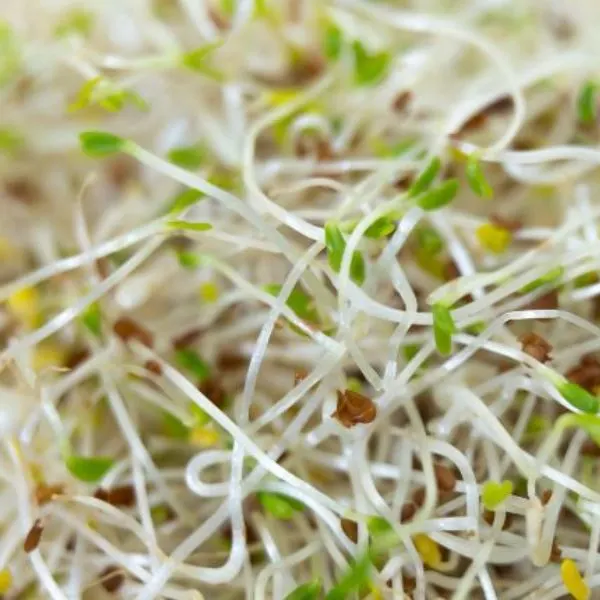
Known also as lucerne but more commonly called alfalfa in North America, this legume is a perennial flowering plant in the biological family Fabaceae.
It is grown as a forage crop for grazing, hay, silage, green manure, and as a cover crop.
Orchards usually have poor soils because the trees take up lots of soil nutrients.
Many legumes, like alfalfa, and some grasses are used as cover crops. They help to replenish depleted soil by fixing nitrogen in it.
Alfalfa is also a good companion plant for apple trees and other trees in your orchard because it slows down the rate of erosion, retains moisture in the soil, prevents weeds from growing, and helps control pests and diseases.
Legumes like this increase the yield of your tree by improving the health of the soil.
After growing alfalfa plants for more nitrogen and other nutrients, you can mulch them.
They serve as manure this way, acting as fertilizer.
These cover crops provide a great source of biomass (plant-based material used as fuel to produce heat or electricity) and food for plants.
Growing alfalfa in between apple trees can also provide food for livestock.
2. Artemisia
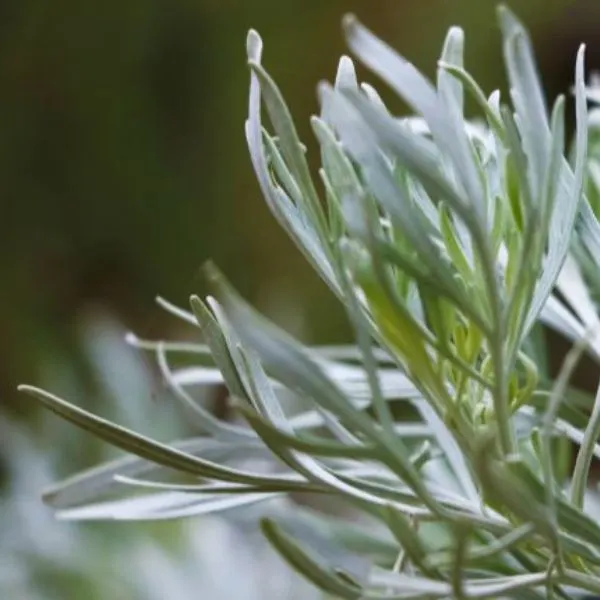
The diverse genus of plants known as Artemisia consists of about 200 to 400 species.
They belong to the biological family Asteraceae, also known as the daisy family.
Plants in this genus are also called mugwort, sagebrush, or wormwood.
When used as companion plants for apples, they serve as trap crops.
Trap crops are plants that are grown to attract pests, mostly insects, and keep them from destroying nearby crops that the farmer or gardener wishes to preserve.
In this instance, plants in the genus Artemisia are planted near apple trees.
Pests that usually attack apples are then attracted to the mugworts, saving the apples from infestation.
The main crop, the apple, is preserved without using pesticides.
With their naturally harsh taste and strong odor, mugworts are also able to repel certain insect pests (fleas, flies), insect larvae within the soil, and nibbling animals like deer and rabbits.
You can grow plants in this genus under the canopy of your tree.
This is because although they love to grow under full sun, most varieties of plants in the genus Artemisia are tolerant of partial shade.
3. Basil
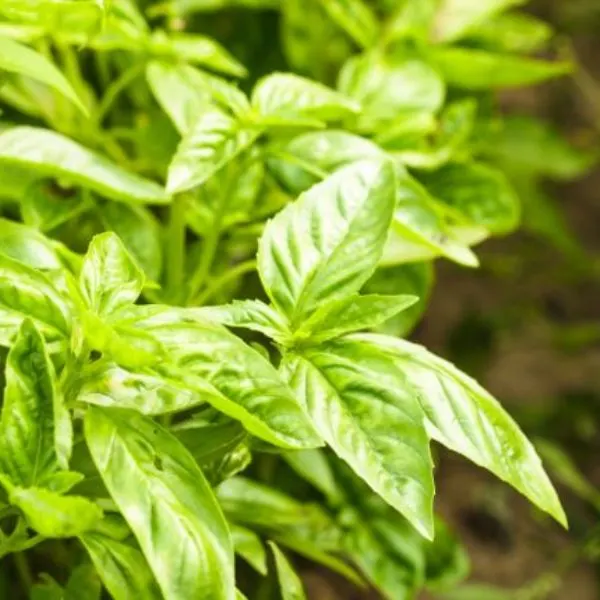
Basil or great basil is a herbaceous flowering plant in the mint family Lamiaceae.
The tender plant is cultivated for its leaves and flowers which are mostly used for food in several cuisines.
Its seeds may be soaked for use in drinks and desserts.
This herb is another good companion for apple trees.
It can be planted under your tree because although basil likes to be under full sun, it needs shade to avoid being scorched.
It also requires its soil to stay moist and the shade can aid this.
Just like other herbs, basil is very aromatic and has a strong smell.
It contains oils in the leaves that can be released by gentle touch.
The odor can keep certain pests and rodents away from your apple tree and other companions around.
Some insects that are repelled by this herb are asparagus beetles, carrot flies, mosquitoes, whiteflies, and worms.
Rodents like mice and rats are turned off by their smell. In addition to deterring pests, basil attracts beneficial insects.
Apple trees can benefit from basil’s ability to bring pollinators like bees and butterflies to the vicinity.
Because basil needs its own pests kept away as well, you can plant chamomile, chives, and marigolds around because these are also good companion plants for your apple tree.
4. Chamomile

Also spelled camomile, chamomile is a flowering plant of the daisy family Asteraceae and it resembles a daisy actually.
Some parts of this plant are used in the making of healthy beverages because of its antioxidant properties.
Chamomile is another good companion plant for apple trees.
With its low moisture needs and requirement of partial shade in hot climates or weather, it is quite easy to grow and can be planted in the underbrush of your apple tree.
Just like alfalfa and other legumes, this plant fixes nitrogen in the soil.
Nitrogen is a very important nutrient for fruit trees as they need it to produce amino acids and proteins.
Both are essential for your tree to produce healthy fruits.
The beautiful flowers of chamomile plants are also able to attract beneficial insects.
Some of such insects are predators of common pests of apple trees and other plants.
Examples are honey bees, hoverflies, ladybugs, and beneficial wasps.
Other beneficial insects that chamomile attracts are bees, butterflies, and pollinators.
This plant can improve the yield of your tree and the quality of its fruits by providing more nutrients and attracting beneficial insects to the orchard.
5. Chickpeas
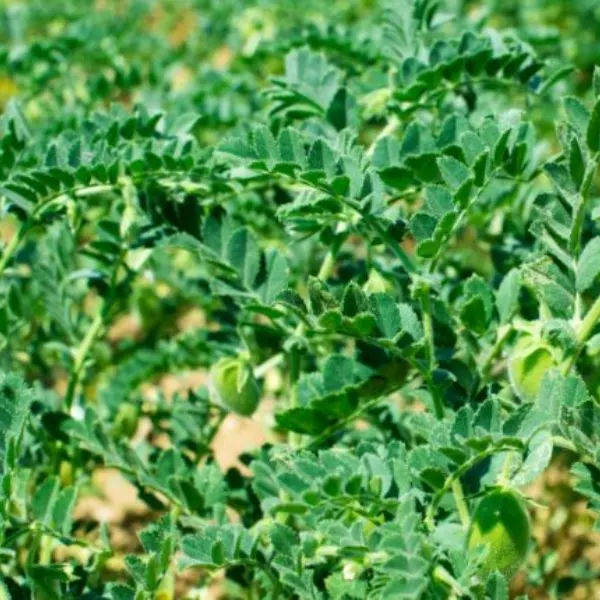
Another plant in the legume family Fabaceae is the chickpea or chickpea.
It is a flowering annual crop grown for its edible seeds which are high in protein.
There are different types known as gram (Bengal gram), garbanzo (garbanzo bean), or Egyptian pea.
A legume like a chickpea is a good companion for apple trees.
It serves as a cover crop, improving the health of the soil in various ways.
Cover crops slow the rate of erosion, help to retain the water content of the soil, and prevent weeds from growing in empty patches.
They also improve the quality of both soil and crop yield by replenishing nitrogen in depleted soils.
Chickpeas and other legumes promote beneficial bacteria that take nitrogen from the air, storing it in the soil as nitrates for other plants’ use.
After growing this plant for the many benefits and nutrients that it provides your apple tree, you can then mulch it.
Adding a layer of chickpea plants over the soil reduces evaporation, provides a source of biomass, and serves as food for plants.
6. Chives
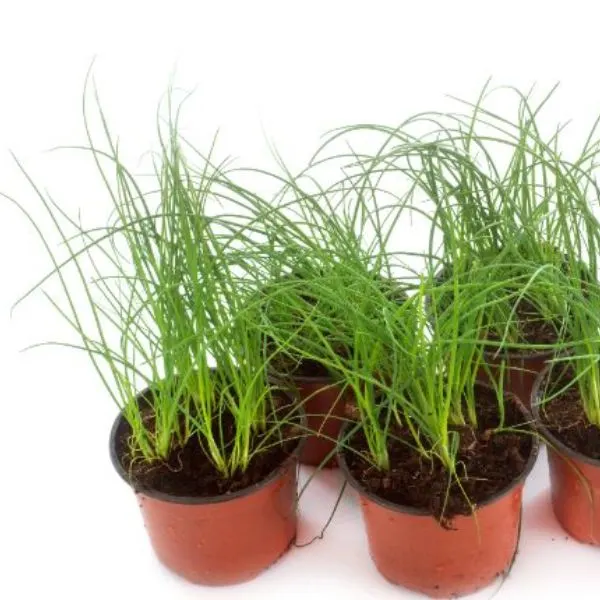
Chives are flowering plants in the genus Allium, just like garlic, onions, and shallots.
They are cultivated for the edible leaves and flowers they produce. Parts of the plants are then used as a seasoning in food, with flavors of onion and garlic.
These plants are very good companions for apple trees.
They have shallow roots that do not compete with your tree for nutrients and so they can be planted near or underneath it.
They like full sun and lots of moisture.
Chives can however thrive in partial sun as well as in full exposure to sunlight.
It is even advisable to plant them under the apple tree in hotter climates or weather so that they are relieved from the heat of the sun and not scorched.
Alliums like chives have sulfur in them.
This sulfur content is the reason for their strong, insect-repellent smell.
It is also a natural anti-bacterial compound and fungicide, making these alliums suitable for pest and disease control.
Planting chives near your apple tree is sure to provide many benefits to both the tree and the plants in close proximity to it.
The most evident is repelling insect and animal pests with their pungent taste and odor.
Some of the pests that chives repel include aphids, beetles, maggots, mites, deer, and rabbits.
They can protect your crops from fungal diseases. Apple scab is one such disease that attacks and has detrimental effects on apple trees.
It destroys the leaves — negatively affecting photosynthesis, reduces the tree’s fruit production, makes the fruits unhealthy to the eyes by warping their shape or spotting in olive green color, and makes your apple tree very weak.
When chives are planted alongside apple trees, they can aid in the alleviation of this problem.
Also, when their leaves are chopped, boiled in water, left to cool, and sprayed on leaves, they help in the prevention of mildew.
A chive plant left to bloom produces flowers that attract bees and wasps which aid pollination.
Wasps and other predators of apple insect pests are also attracted to these flowers.
Chive’s benefits do not stop there.
This plant can also prevent soil erosion.
It has shallow but very dense roots that help your soil stay in place and its clippings can be used as mulch.
It is important to note that they spread fast, so ensure they do not dominate the area.
7. Cicely

Garden myrrh, myrrh, sweet chervil, sweet cicely, or cicely is a flowering herbaceous plant that belongs to the celery family Apiaceae.
This perennial plant with beautiful white and yellow flowers is the only species in its genus Myrrhis.
Cicely is another good companion plant for apple trees.
It grows best in rich soil that contains consistent moisture.
It also prefers some amount of shade so planting it under your apple tree is a good move.
This herb attracts beneficial insects to your orchard.
Although it does not have the inherent ability to deter pests, it attracts tachinid flies.
They are natural predators of several insect pests of the apple tree.
The tachinid fly lays eggs near or on its prey and when the eggs develop into larvae, they eat their way out of their hosts, killing them in the process.
Cicely also attracts honeybees, other predatory insects, and other pollinators.
8. Clover
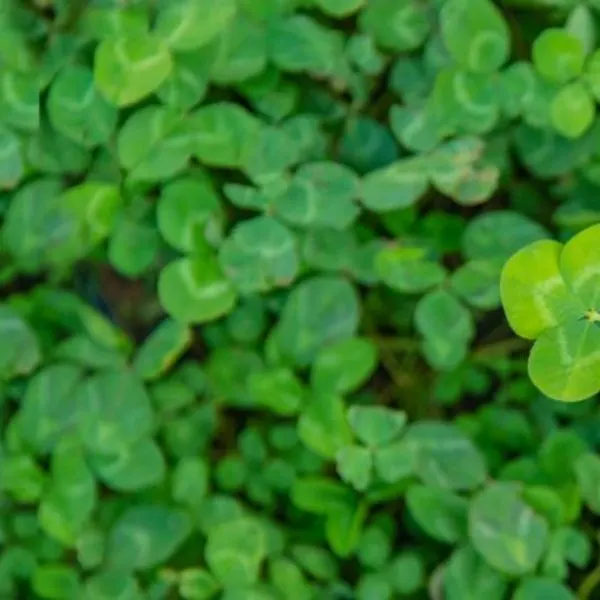
About 300 species of flowering leguminous plants in the genus Trifolium are more commonly known as clovers or trefoils.
They belong to the family Fabaceae, the bean, pea, or legume family. They have both culinary and medicinal uses.
Just as the other legumes cited above, clover fixes nitrogen in the soil and serves as a good cover crop.
It re-energizes the soil by replenishing depleted nutrients and thus increases the yield of plants around it.
Apple trees need nitrogen to produce amino acids and protein for their growth and health.
The soil in orchards may not provide this essential nutrient because so many other crops are vying for it.
This is where clover and other legumes come in and prove helpful.
They promote beneficial bacteria; these then take nitrogen from the air, storing it in the soil as nitrates for other plants to use.
Nitrogen is then replenished within the soil.
Clovers are also vital and beneficial companions in the orchard as cover crops.
They slow down the rate of erosion, retain soil moisture, prevent weeds from growing and control the spread of pests and diseases.
In doing so, clover helps improve the quality of your apples.
You can mulch the plant afterward to provide a great source of biomass and food for both plants and livestock.
So in addition to your tree having manure, your livestock gets food.
9. Comfrey
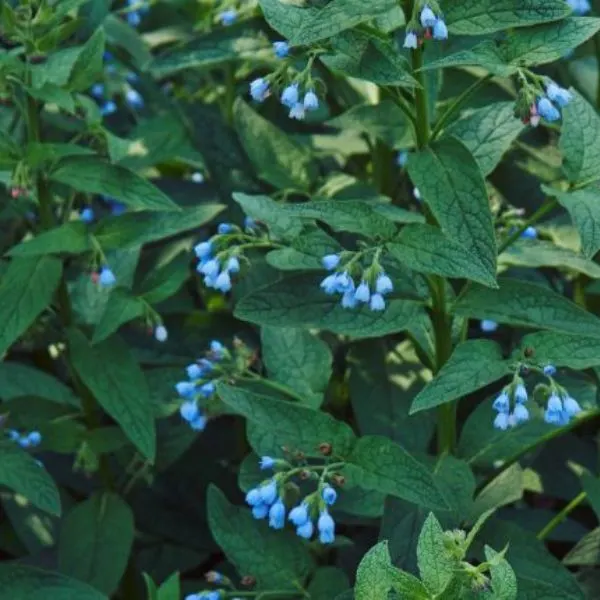
Yet another genus of flowering plants suitable for growing beside your apple tree is comfrey.
The flowers of these tall-growing plants bring numerous benefits to your orchard and even to vegetable gardens.
Symphytum is the scientific name of the genus of plants more commonly known as comfrey.
It belongs to the borage family Boraginaceae and consists of up to 35 species.
Several species and hybrids are used in gardening and as herbs.
The flowers of comfrey are very beautiful and aesthetically pleasing to grow in your orchard or garden.
Because of this, they attract many beneficial insects to your apple tree and other plants around them.
Pollinators like bees and butterflies are encouraged to visit your orchard by these flowers’ presence.
It also attracts some other insects which are predators of common insect pests.
This plant controls insect pests and repels animals like deer.
Comfrey also fixes nitrogen in the soil.
The roots of this plant attract beneficial bacteria which then take nitrogen from the air and store it in the soil as nitrates which plants can then use.
Plants cannot turn nitrogen into nitrates on their own.
In addition to fixing nitrogen for its companions, the plant comfrey can release other beneficial nutrients into the soil for plants to use, like phosphorus and potassium.
When many are planted, they act as barriers against the spread of weeds.
Comfrey grows very fast and tall.
This can prove to be a problem if the plant is left unchecked.
You can solve this by planting Russian comfrey. Many gardeners and farmers like to use this variety because its seeds are sterile.
This tall plant eventually falls over and serves as mulch for other plants, reducing the evaporation of water from the soil and so retaining its moisture.
Another plant that can provide such benefits is borage.
10. Daffodil

Also known as jonquil or narcissus, the daffodil is a genus of flowering perennial plants of the family Amaryllidaceae, the amaryllis family.
Species usually have solitary yellow nodding flowers that predominantly bloom in the spring.
Daffodils will be very comfortable growing outside the shade of your apple tree.
They are not edible but grown for their striking flowers. As stated above, they should be grown 25 to 50 feet away from your apple tree.
They really love being exposed to full sunlight and require a lot of moisture.
They provide warm, sunny colors by virtue of their flowers.
Your garden or orchard looks beautiful and aesthetically pleasing, attracting beneficial insects to it.
European honey bees, monarch butterflies, and rusty-patched bumble bees are some pollinators that daffodils bring to their vicinity.
They also repel deer, rabbits, and rodents like mice and rats.
The flowers of daffodils are susceptible to attacks from slugs and some other insect pests.
It would be beneficial to plant them around crops that deter their pests but are also good companions for apple trees, like alliums (chive, garlic, onion).
11. Dandelions
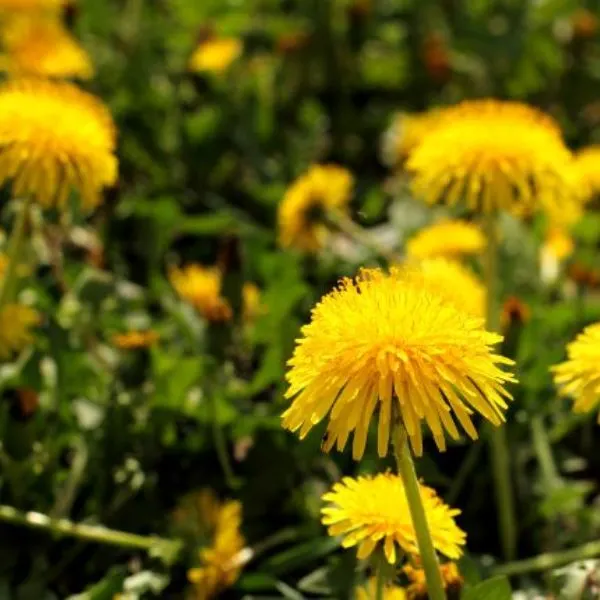
Dandelions are a species of flowering plants in the genus Taraxacum. This large genus belongs to the daisy family Asteraceae.
The name dandelion is only a more common name for the plants in this genus studied in toxicology.
They typically have a rosette of leaves and large bright yellow flowers, followed by globular heads of seeds with fluffy tufts and clusters.
They are widely distributed and considered by some as weeds.
The popular idea is a misconception because the reason why dandelions are so widespread is that they improve damaged or depleted soils.
Like comfrey, legumes, and several other cover crops, they fix nitrogen in the soil.
Because plants cannot convert the nitrogen in the air into absorbable nitrates for their use and growth, nitrogen-fixing plants like these promote beneficial bacteria in their roots that perform this conversion, leaving nitrates for plants in the soil.
Dandelions can also benefit apple trees by serving as mulch later on.
They conserve water in the soil thus preserving its moisture content, protecting it from erosion, shielding it from severe temperatures, and providing a source of biomass.
When growing, dandelions like to receive at least six hours of direct sunlight.
However, if you intend to consume their edible leaves, find suitable shade to avoid them getting bitter.
Their flowers are commonly used to make homemade products.
12. Dill
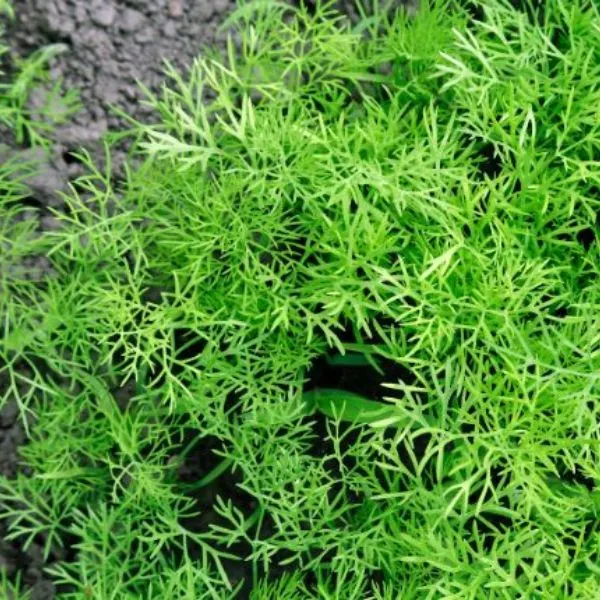
Dill is an annual herbaceous plant in the celery family cultivated for its leaves and seeds.
These may be used as herbs or as a seasoning for food.
This plant, widely grown in Europe and Asia, is a very good companion for apple trees.
It is suitable for planting near or beneath your apple tree.
The plant prefers full exposure to sunlight for around six to eight hours daily but it tolerates partial shade as well.
Dill also likes consistent moisture in its soil.
When it has bloomed and produced flowers, the plant helps attract useful insects to the area.
The flowers attract insects like bees and butterflies that aid pollination. This ensures that your plants are healthy, producing larger and more nutritious fruits.
Pollination also helps your tree and plants around reproduce, producing enough seeds for dispersal and propagation.
Dill’s flowers also draw insects that feed on the pests of your apple tree, improving the tree’s health.
Hoverflies, lacewings, ladybugs, and beneficial wasps are some such insects that dill attracts.
While they aid pollination, the larvae of hoverflies feed on aphids, caterpillars, thrips, and scales.
This reduces the level of infestation of these pests.
Lacewings help control many insect pests: aphids, whiteflies, caterpillars, leafhoppers, mealybugs, and mites.
Ladybugs prey on aphids, beetles, corn borers, mealybugs, and spider mites.
Wasps control aphids, caterpillars, grubs, and weevils.
13. Dogwood
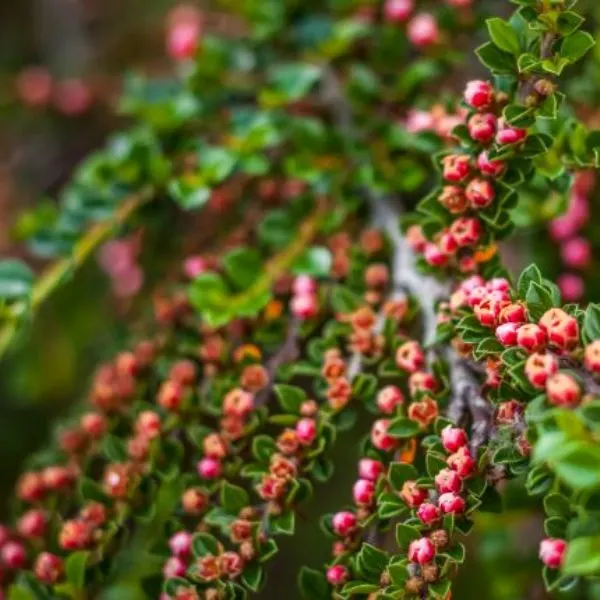
Dogwoods are woody plants, shrubs, or small trees in the genus Cornus that belong to the biological family Cornaceae.
There are around 30 to 60 species in this genus. Most bloom, producing white flowers, but size and color vary by species.
These plants are cultivated for the hard timber that they yield and their decorative foliage.
Their bark, blossoms, colorful berries, and red stems are very distinctive.
They are native to north temperate regions.
Like with cicely, planting dogwood alongside your apple tree can provide the benefit of pest control.
It attracts useful insects to your garden or orchard, including those that aid in pollination and those that eat apple tree pests.
Bees, beetles, butterflies of several species, giant silk moths, and many other pollinators cum pest predators are attracted to dogwood.
Aphids, harmful beetles, flies, mealybugs, mites, scales, thrips, and young whiteflies are controlled by these.
14. Fennel
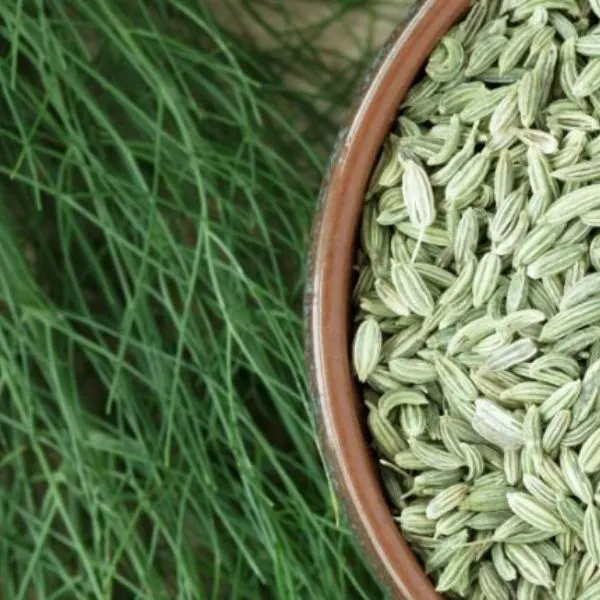
Another good companion plant for apple trees is fennel.
This is a species of perennial flowering plant in the carrot family Apiaceae.
They are hardy herbaceous plants that have yellow flowers and feathery leaves.
Fennel is an allelopathic plant, a plant that produces some allelochemicals.
Allelochemicals are biochemicals that affect growth processes (like germination and reproduction) and the survival of other organisms negatively or positively.
The allelochemicals that fennel produces make it undesirable for companionship with many other plants, as they tend to have negative effects on and inhibit the growth of such crops.
For this reason, it is advisable to plant it at least 1 foot away.
The herb attracts beneficial insects such as bees of different types (like bumble bees, honey bees, wild bees), beetles, flies, hoverflies, and wasps to your apple trees.
Bees, beetles, flies, and wasps aid pollination.
Ants, aphids, caterpillars, crickets, frog hoppers, mealybugs, mites, nematodes, protozoans, scales, and spiders are some pests that the predators named above feed on.
Growing fennel can reduce their infestation in your orchard.
15. Garlic
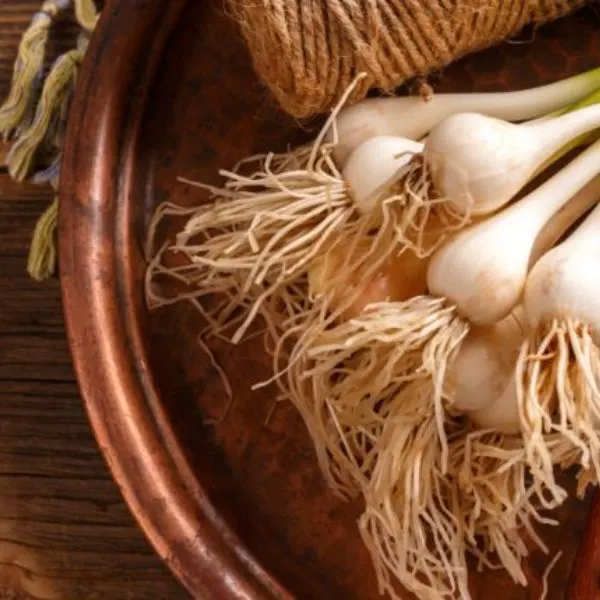
Garlic is a flowering plant in the genus Allium, just like chives, leeks, onions, and shallots.
It has a pungent bulb divided into cloves which are used as a seasoning for food or to make an oil sprayed to deter pests.
This aromatic plant is a great pest deterrent, known to repel several pests including aphids, cabbage loopers, maggots, and spider mites.
This is because it contains sulfur, a natural pest repellent, a fungicide, and an antibacterial compound.
Japanese beetles and plum curculios are pests that affect apple trees.
Growing garlic can keep this away and prevent weeds from growing.
It is very effective also in keeping animal pests like deer and rabbits away from your apples.
Some plant diseases can be prevented from spreading by the presence of garlic and the sulfur in it.
Fungal and bacterial diseases can be treated using organic sprays made from neem oil and garlic cloves.
Because the horizontal roots of garlic plants are shallow, you can plant them near or under the canopy of your apple tree.
They also thrive in both full sun and partial shade. Plant them under your tree in hotter climates or seasons.
16. Geraniums
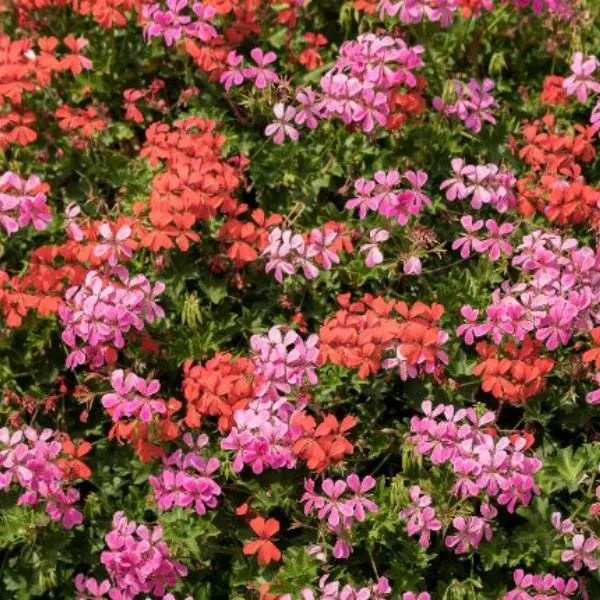
Geranium is a genus of about 422 species of flowering plants also known as cranesbills.
They may be annual, biennial, or perennial plants and are grown in tropical parts of the world.
They bear a long, narrow fruit resembling the bill of a crane.
Most geraniums, especially the annual species, need full exposure to sunlight for proper growth and development.
They do love moist soil but it is advisable to let their soil dry a little before watering again to reduce the risk of overwatering.
Geraniums serve as good companion plants for apple trees.
They help control pests and contribute to the health of the soil.
You can plant them under the shade of your tree or just around them, but not more than 50 feet away.
This is to ensure that pollination occurs after the plant’s lovely flowers have attracted pollinators to that area of your orchard.
The beautiful flowers which come in several colors (lilac, red, pink, purple, and white) attract butterflies and hummingbirds.
In addition to aiding pollination, hummingbirds prey on insect pests like ants, aphids, mosquitoes, and wasps.
Many others like cabbage worms, earworms, and Japanese beetles are repelled by the geranium itself.
17. Hyssop
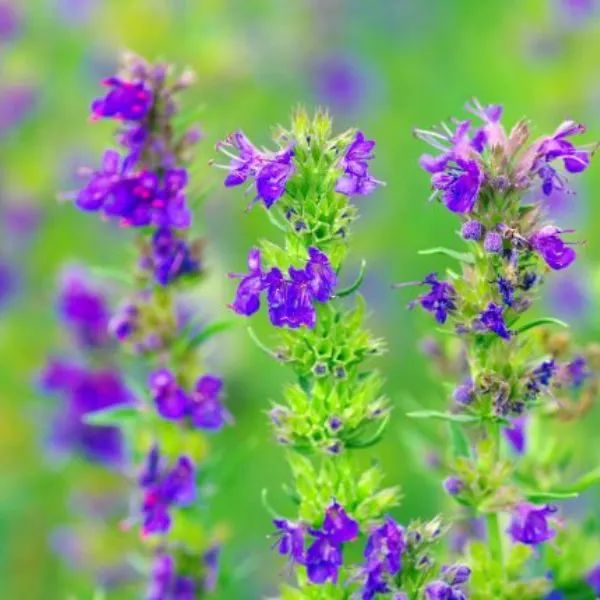
Hyssop is a herbaceous flowering plant in the mint family Lamiaceae.
It has aromatic, pungent leaves. The parts that grow above the soil may be used in the making of perfumes and herbal medicine or as a seasoning for culinary purposes.
A very useful companion plant, hyssop attracts useful insects that aid pollination and feed on pests of apple trees.
Its flowers are most commonly purple but there are some individuals which have white or pink flowers.
These flowers attract bees, beetles, butterflies, hoverflies, and parasitoid wasps.
They help with pollination while also eating many pests. Its aromatic oils repel cabbage moth larvae, flea beetles, and slugs, thus benefiting your tree and other crops.
When planted densely, hyssop serves as ground cover.
It shields the soil from excess evaporation, retaining its water content.
It also prevents the growth of weeds which can compete with your plants and deplete nutrients in the soil.
Grow hyssop around your apple tree but not underneath its canopy because the herb prefers full, direct exposure to the sun.
It does not do the best while being shaded. It does not like soggy soil and thrives in neutral or alkaline ones.
18. Lavender
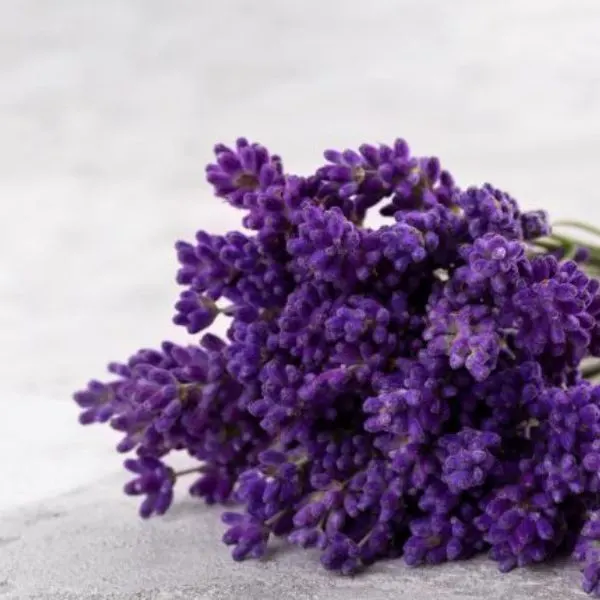
Another ideal companion for your apple tree is lavender.
This is a genus of flowering plants belonging to the mint family Lamiaceae.
Plants in this genus are cultivated for culinary, medicinal, and ornamental purposes.
A naturally drought-resistant plant, lavender requires well-draining, moist soil.
Letting your lavender’s roots sit in soggy soil encourages root rot. It also needs exposure to full, direct sunlight so plant it near your tree but not under it.
The beautiful predominantly purple flowers of this plant can help bring bees and butterflies to your garden.
These seem to be the only insects that like lavender as many others tend to stay away from the aromatic plant.
Bees and butterflies aid pollination between plants but do not feed on plant pests.
Thankfully, the aromatic oils contained in lavender are able to deter several pests, including fleas, flies, mosquitoes, moths, slugs, snails, and ticks.
Codling moths are very detrimental to the health of your apples. Females lay numerous eggs on young apples and when they grow into their next developmental stage, larvae bore holes into the fruits, making them inedible.
Lavender keeps codling moths, other species of moths, and rodents (like rats and mice) away from your orchard.
It stops the infestation of these pests, keeping your apple trees and their fruits healthy by doing so.
19. Lemongrass
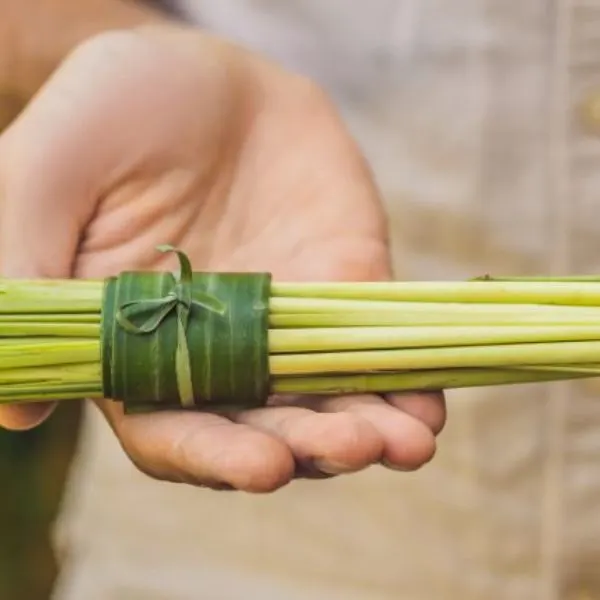
Known by many other names like barbed wire grass, Malabar grass, citronella grass, fever grass, Cochin grass, or silky heads, lemongrass is a genus of tropical monocotyledonous flowering plants, Cymbopogon, in the grass family Poaceae.
The genus is of African, Asian, Australian, and tropical island origins. Lemongrass needs full sun for optimal growth, even though it grows well in shade.
Do not plant species of this genus underneath your apple tree, just grow them near it.
Lemongrass needs consistent moisture and well-draining soil.
It serves as a good ground cover. Playing this role, the plant conserves soil moisture by preventing water loss caused by evaporation and prevents weeds from growing in the area.
This grass plant also produces an oil, lemongrass oil, which is effective at repelling aphids, houseflies, and mosquitoes.
A fun fact is that it can be eaten as well. It is used in several Asian cuisines in dishes containing tomatoes and pepper.
20. Lentils
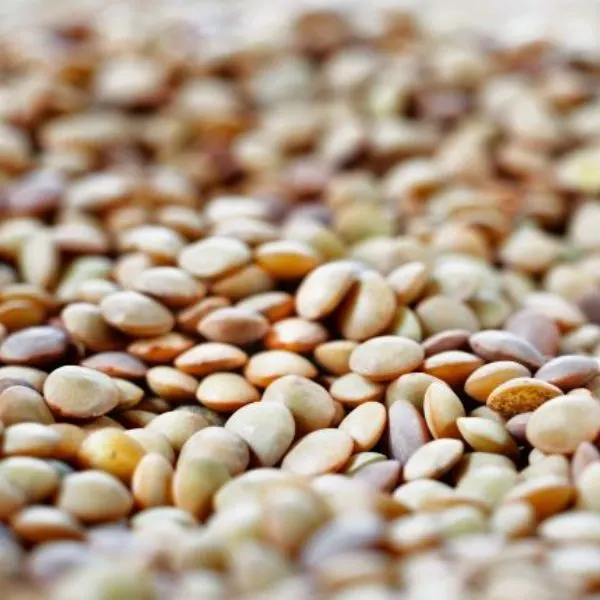
Lentil is yet another leguminous plant in the biological family Fabaceae which serves as a good companion for your apple tree.
The annual plant produces edible, lens-shaped seeds that grow in pods. There are usually two seeds in each pod.
The tall growing legume first serves as a nitrogen-fixing plant before it is mulched.
It can help restore and renew depleted nutrients in poor soils like those often found in orchards.
Of course, the result of this is better crop yield.
Nitrogen is an important nutrient for the growth of your crops and trees especially.
Your apple tree needs the nutrient to produce proteins and amino acids. But it can only absorb nitrogen in the form of nitrates.
Apple trees and other plants cannot convert the nitrogen in the atmosphere to nitrates on their own.
Thankfully, some bacteria in the root nodules of legumes can take this nitrogen from the air and convert it to nitrates for other plants to use.
Lentils also serve as good ground cover, improving the health of the soil generally.
They do so by slowing down the rate of erosion, retaining water in the soil, preventing weeds from growing, and stopping pests and diseases from being spread.
After growing lentils, you can mulch them.
This provides your apple tree and other plants with the same benefits feasible during the lentil’s life even afterward.
An additional benefit is the provision of food for your livestock if you own any.
21. Marigolds
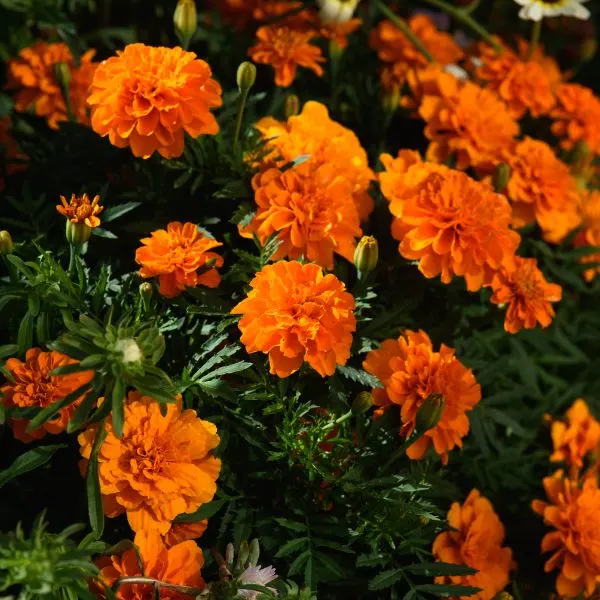
A marigold is any species of herbaceous flowering plant in the genus Tagetes of the aster family Asteraceae.
One plant has green, pinnate leaves and brightly colored flowers.
It’s very beautiful flowers may be yellow, white, orange or golden.
Marigolds have a repellent effect on several pests that easily and commonly affect many crops in your orchard or garden.
They are able to keep aphids, cabbage worms, hornworms, nematodes, squash bugs, thrips, and whiteflies away.
A companionship between marigolds and apple trees can help reduce the infestation of pests like aphids, thrips, and ash whiteflies, insects that can negatively affect your tree.
To top it off, the plant’s flowers attract beneficial insects.
They are attractive to bees, butterflies, hoverflies, lacewings, ladybugs, predatory mirid bugs, and beneficial wasps.
Not only do these insects foster pollination between plants, but some are also natural predators of common plant pests.
In all, planting marigolds near your apple trees is beneficial.
By their flowers, they attract beneficial insects; by their oils, they deter pests; by chemicals present in their roots, they kill nematodes.
Grow them outside the shade of your apple tree.
22. Nasturtiums
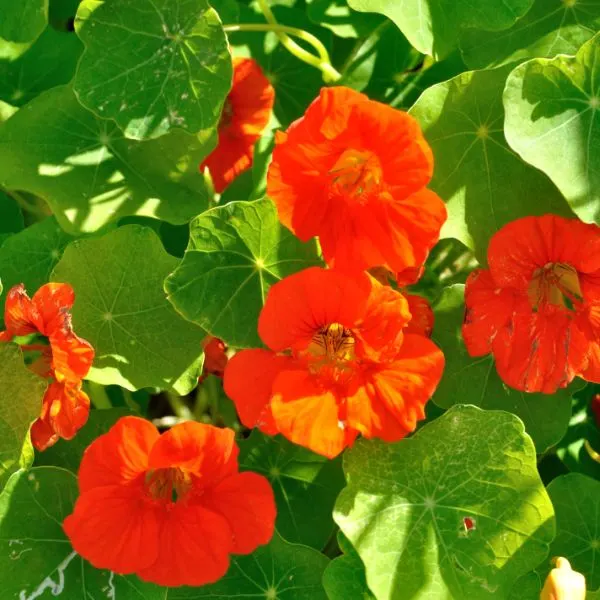
Also known as Tropaeolum, nasturtium is a genus of plants that contains several creeping herbaceous plants which may be annual or perennial.
These plants have showy round flowers and may be used in herbal medicine or cooking.
As creeping plants grow quickly and horizontally along the ground, nasturtiums have been believed to be weeds.
They however can serve as ground cover in your garden or orchard to maximize space.
They hereby reduce the water loss that evaporation causes, protect the soil from exposure to excessive sunlight, and reduce the likelihood of erosion occurring.
The shallow roots of the plant help control erosion and are ideal for your apple tree because it means that there will be little to no competition for nutrients between the two crops.
Nasturtiums have other benefits apart from cover cropping.
With their very beautiful and conspicuous flowers, they are able to attract beneficial insects to your apple tree when they grow side by side.
Apple trees are susceptible to attacks from whiteflies, especially ash whiteflies.
The scent of nasturtium can help your apple tree by repelling these insects.
The plant can also serve as a trap crop for aphids and cabbage loopers, ensuring that these pests do not bother attacking your other crops.
Nasturtiums are resilient and can handle attention.
They not only attract these pests, but they also bring pollinators and beneficial insects to your orchard.
This is due to the sweet nectar in their edible flowers.
Hummingbirds and bees are attracted to the inflorescence of nasturtiums.
These animals move pollen grains, thus aiding pollination. Nasturtiums can be planted under your apple tree because they thrive in partial shade.
23. Onions
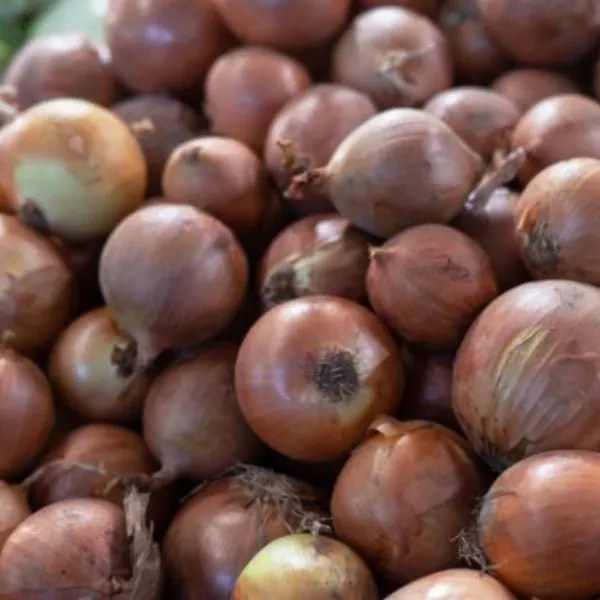
The most widely cultivated plant in the genus Allium is the onion, also called bulb onions or common onions.
It has bluish-green leaves and a bulb at its base. It is closely related to chives and garlic and produces a sharp odor like them.
Like its relatives, the strong odor of this plant is likely due to the sulfur that it naturally contains.
This makes onions good for repelling pests as well as controlling some plant diseases (it is a natural antibacterial and fungicide).
If planted near apple trees, onions can deter aphids, deer, maggots, mites, and rabbits.
They can also prevent, to an extent, the spread of various diseases between plants, most especially soil-borne ones.
They can be planted near or under apple trees. Their roots are shallow and will not compete with your tree for nutrients or water (especially if they are well watered in the first year).
Also, onions grow well in both full sun and partial shade.
In hotter climates or weather, consider growing your onion plant underneath the canopy of your apple tree.
This will make sure that your plant gets some shade from the sun and is not scorched.
24. Parsley
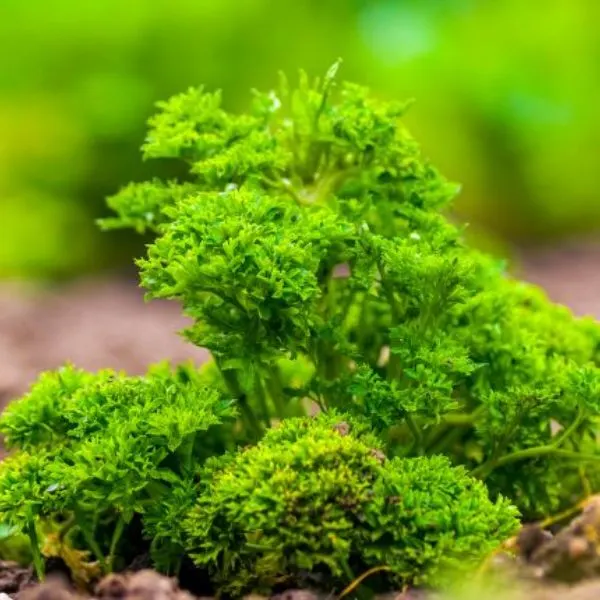
Parsley, also less commonly called garden parsley, is a flowering plant cultivated widely across the world for use as a medicinal herb or in cooking as a vegetable.
This aromatic plant belongs to the biological family Apiaceae.
Parsley is a very good companion plant for apple trees.
It is fairly easy to grow, repels several common pests, and attracts useful insects.
It encourages the growth of many plants near it this way and makes for a healthy plant environment.
Codling moths are enemies of apple trees.
Their larvae feed on apples because they cannot eat the leaves of the tree.
They leave your apples unhealthy and infested, reducing yield after the hard work put into growing your tree.
However, with parsley around, the infestation of these moths is significantly reduced.
The herbaceous plant attracts insects that prey on these moths and other pests. Hoverflies, tachinid flies, and beneficial wasps are some pest predators.
The larvae of hoverflies eat aphids and thrips.
Tachinid flies are parasitic, feeding on beetles, caterpillars, squash bug nymphs, stink bugs, and larvae of other flies.
Asparagus beetles and some other beetles are repelled by parsley too.
25. Peanuts

Known also as goober, groundnut, monkey nut, or pindar, the plant groundnut is yet another leguminous crop belonging to the family Fabaceae.
The flowering plant is mostly grown in the tropics and subtropics for its edible seeds.
Peanuts can promote the health of the soil, your apple tree, and other crops in your garden by fixing nitrogen in the soil.
It encourages beneficial bacteria in its root nodules to convert atmospheric nitrogen into nitrates for other plants’ benefit.
They also serve a purpose as cover crops.
They protect the soil from erosion, preserve soil moisture by preventing water loss from evaporation, inhibit the growth or spread of weeds, and control pests and diseases.
As is obtainable with other cover crops, you can mulch these plants after growing them.
Mulching protects the soil from harsh weather conditions like excessive sunlight or rainfall, keeps it from erosion, and conserves soil moisture.
In addition to the above, mulching provides a great source of biomass and food for both plants and livestock.
They end up serving as manure for your soil, fertilizing it and improving its health. It is advisable to plant peanuts near your apple tree.
26. Peas
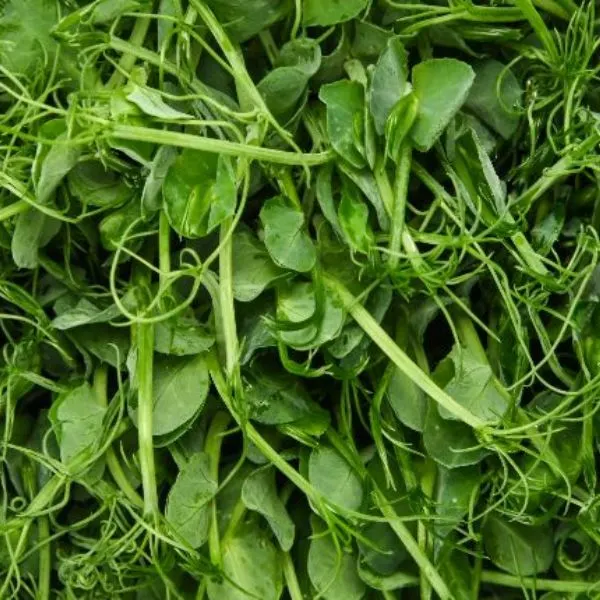
A pea plant is an annual herbaceous flowering plant in the biological family Fabaceae.
Also known as garden pea, the plant is cultivated in various parts of the world for its edible seeds, peas.
It is not a vegetable but it is cooked as such.
The plant is leguminous, meaning that it benefits your apple tree in about the same way other legumes listed above do.
It helps fix nitrogen in the soil, serves as a cover crop, and may be used as mulch after it is grown.
Peas replenish used-up nutrients in the soil.
They do this by aiding the conversion of atmospheric nitrogen into nitrates that other plants can absorb and use.
Your apple tree and other crops benefit because this nutrient is very important.
As a cover crop, the pea plant improves soil health and leads to an increase in crop yields by preventing erosion, conserving water in the soil, discussing the growth of weeds, and controlling the spread of pests and diseases.
You can mulch this cover crop after growing it to release even more nitrogen, reduce the water loss that evaporation can lead to, protect the soil from excessive sunlight or rainfall, be a source of biomass and provide food for plants and animals.
27. Rosemary

This is a woody flowering perennial plant belonging to the mint family Lamiaceae.
The aromatic herb has thin, fragrant, evergreen, and needle-like leaves.
Owing to the oil it yields, it is aromatic and grown for use in both medicine and cooking.
Rosemary is another good companion plant for apple trees.
It does not like soggy or damp soil so it prefers slightly moist and well-drained soil.
Plant it outside the canopy of the apple tree as it prefers direct sunlight to partial shade.
The tiny, beautiful flowers that rosemary produces when in bloom attract pollinators to your orchard.
They bring several kinds of bees like bumble bees, honey bees, mason bees, and mining bees to the area.
Rosemary’s flowers also attract butterflies and other flies that feed on nectar to help with pollination, aiding the reproduction of plants.
With its woody scent, the plant is also able to deter several pests from other crops.
It can keep cabbage moths, carrot flies, mosquitoes, and several other kinds of flies.
Rosemary is also good for your apple tree because its relatively short roots do not compete with your apple tree’s deep roots for nutrients.
28. Soybeans
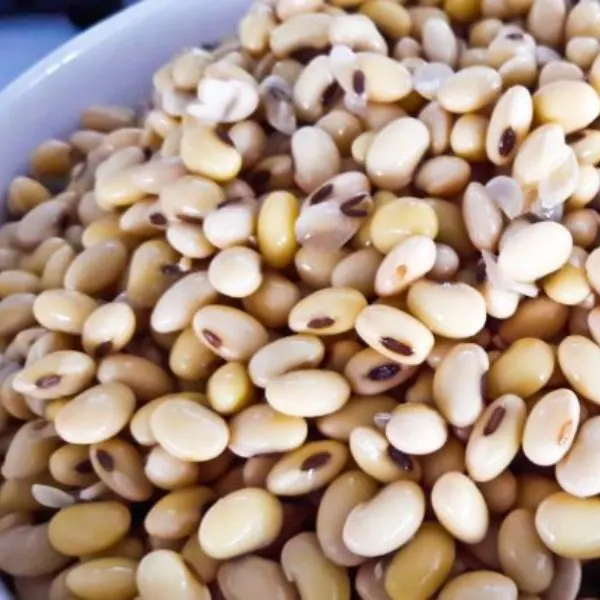
Known by other names like soja bean or soya bean, soybean is an annual flowering plant belonging to Fabaceae, the pea family.
It is grown for its edible seed which goes by the same name and is economically the most valued bean in the world.
Like other legumes, soybean plants fix nitrogen in the soil to replenish depleted or diminished soils and foster the growth of plants.
This nutrient is a very crucial one in the life of your apple tree so the presence of soybean is crucial.
Soybean also serves as a cover crop, reducing the effect of evaporation, preventing erosion, inhibiting the growth of weeds, and containing the spread of diseases and pests.
It is also used for mulching after its growth.
This plant is also a very good source of biomass for plants.
It serves as manure or fertilizer and as food for any livestock you may own.
It is advisable to plant legumes near your tree, and preferably more than one species in this family.
29. Tansy
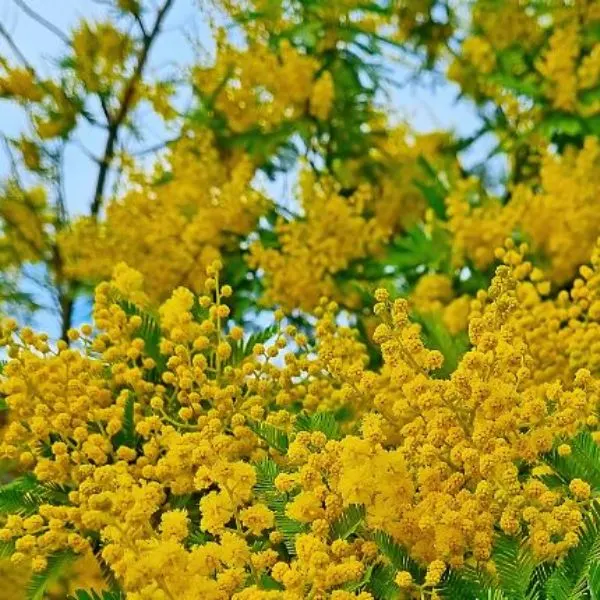
Tansy is a perennial herbaceous flowering plant in the aster family Asteraceae.
This aromatic plant is native to Eurasia, characteristically having yellow button-like flower heads and leaves which have a bitter taste. It may be used medicinally.
The flowers and leaves of tansy can both deter pests and bring useful insects to the area.
As a flowering plant that intends to yield fruit, your apple tree can benefit from these qualities and abilities of tansy.
When planted with apple trees, tansy can control some of their pests like aphids, several kinds of mites, thrips, fruit-eating beetles, leafhoppers, and flies.
It does so by attracting predators of these pests.
Butterflies, honey bees, wasps, and ladybugs, insects that aid pollination, will likely come to your orchard because of the attractive flowers of tansy.
Predators like minute pirate bugs, hoverflies, lacewings, and parasitoid wasps will come too.
30. Wildflowers
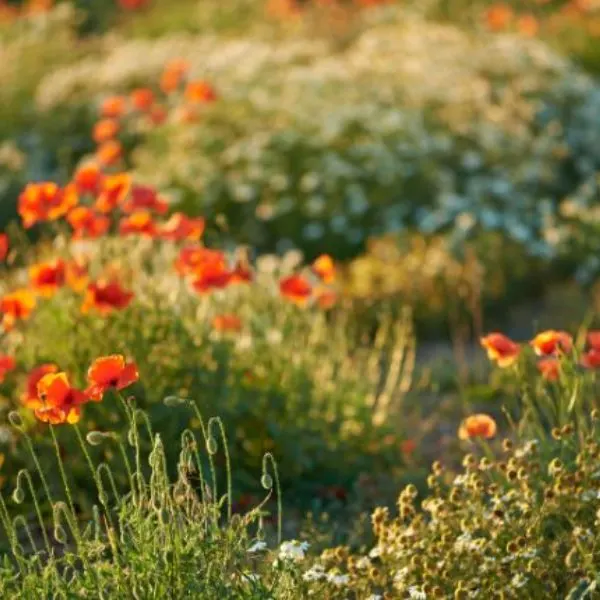
A wildflower is a flower that grows in the wild and was not intentionally seeded or planted.
The term refers to the entire plant, not just its flower, even when it is not in bloom.
There are native species that naturally occur in an area.
Wildflowers are usually not hybrids or selected cultivars of plants that are different in the wild from the way they appear as native plants, even if they are found growing in areas or places where they would not naturally grow.
Some examples of wildflowers are bee balm, black-eyed Susan, cornflower, daisy, lily of the valley, lupine, poppy, primrose, purple coneflower, and windflower.
Some others explained in this article are marigolds, nasturtium, and yarrow.
These plants tend to be good companions for apple trees.
Make sure to plant them outside the canopy of the tree but no more than 50 feet away.
This will ensure that pollinators are drawn to both the wildflowers and your tree.
Some of these pollinators or other insects attracted by the many colors of wildflowers are predators of pests.
Ladybugs can help control aphids, beetles, mealybugs, mites, plant lice, scales, spider mites, thrips, whiteflies, and other insects.
Birds eat beetles, caterpillars, and weevils.
Beneficial wasps feed on many insects that may affect other plants around your apple tree, like armyworms, beetles, cabbage loopers, corn earworms, flies, hornworms, leafhoppers, and thrips.
Apple trees benefit from having wildflowers in close proximity.
They significantly improve the quality of the soil through their roots. These stabilize the soil, holding on to nutrients that could be washed away by rain otherwise.
Their presence serves as a habitat for beneficial insects, helps improve the health of the soil, prevents erosion, improves water quality, increases food production or plant yield, and provides more food or foraging conditions for livestock.
31. Yarrow
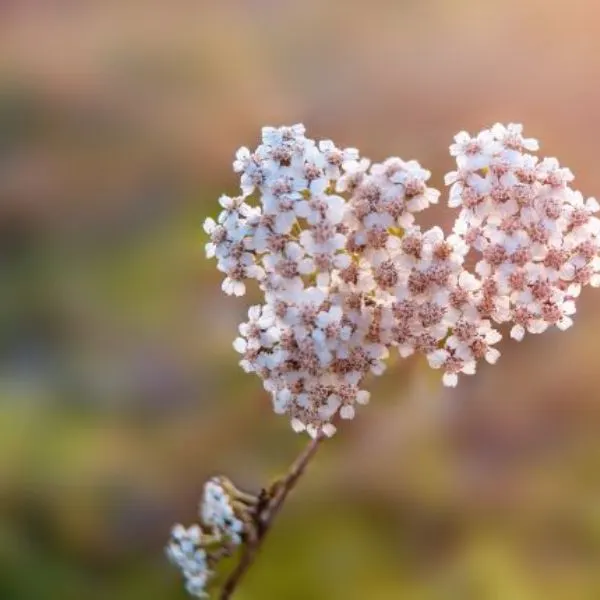
Also known as old man’s pepper, sanguinary, devil’s nettle, soldier’s woundwort, or common yarrow, yarrow is a flowering herb in the aster or daisy family Asteraceae.
It has a sweet scent and its flowers may be white, yellow, pink, or red.
Yarrow is a wildflower, another good companion plant for your apple tree.
It can comfortably grow in the same conditions as this tree and it is fairly easy to grow.
Although it can survive partial shade, it is best to plant it under direct sunlight.
The flowers of this plant are able to attract pollinators to your orchard.
It attracts several types of bees (like bumble bees, digger bees, leafcutting bees, mason bees, miner bees, and sweat bees), beetles, and butterflies which aid pollination.
They also attract predatory insects like braconid wasps, chalcid wasps, damsel bugs, green lacewings, hoverflies, ladybugs, pirate bugs, parasitoid wasps, and robber flies.
As a great source of food, yarrow also attracts aphids, cucumber beetles and flea beetles so be careful with it.
The plant contains oils that are naturally able to repel mosquitoes, ants, several types of flies, and some harmful beetles.
Bad Companion Plants for Apple Trees
1. Carrots
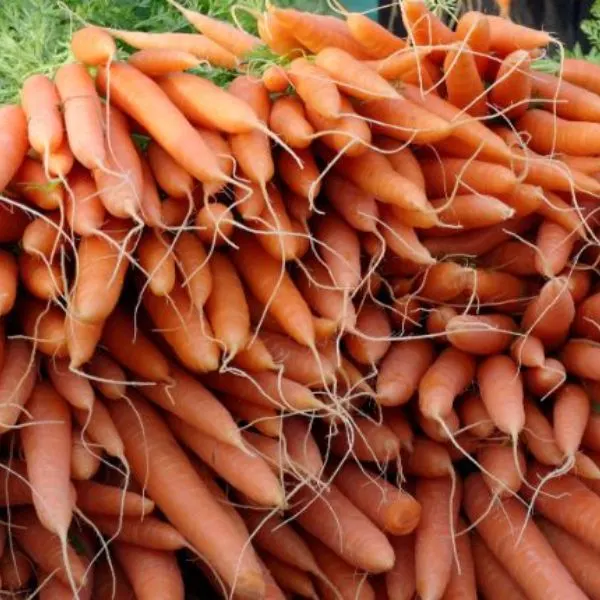
Carrots are edible root vegetables with usually orange taproots and green leaves on top of the root.
Cultivars in white, yellow, red, purple, and black also exist, with this root typically tapering.
As a root vegetable, the carrot has deep roots and these can compete with your apple tree for nutrients, especially when it is still young with shallow roots.
Avoid planting carrots near your young apple tree.
2. Conifers

Conifers are cone-bearing seed plants; are gymnosperms (seed-producing plants) as opposed to angiosperms (flower-bearing plants).
They are perennial woody plants such as firs, cedars, pines, yews, cypresses, spruces, larches, and junipers.
They should not be planted near your apple tree because the methods of reproduction are not the same. Gymnosperms have their gametes found in cones
They do not have flowers to help your apple tree with pollination.
Instead, fertilization in these plants is described as single
The pollen grains of conifers fall and germinate directly on their ovules (the organ that forms seeds).
Pollen spores are spread by wind alone so they do not benefit your tree.
3. Eggplants
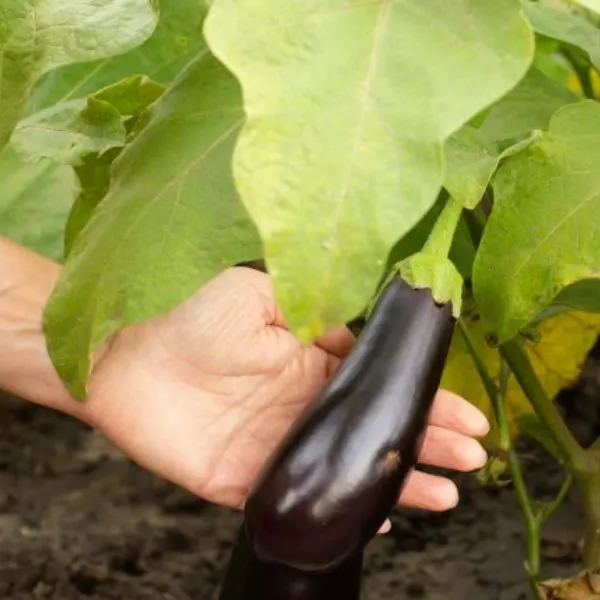
The vining plant called eggplant is also referred to as baby marrow, aubergine, courgette, or zucchini.
It is a summer squash, a herb grown for its fruits which are harvested when they still have immature seeds and soft, edible rinds.
Eggplants belong to the nightshade family Solanaceae.
They have deep taproots which may compete with your apple tree for nutrients.
Keep them far away from the tree, especially in its earlier days, if you intend on planting them.
4. Fruit Trees
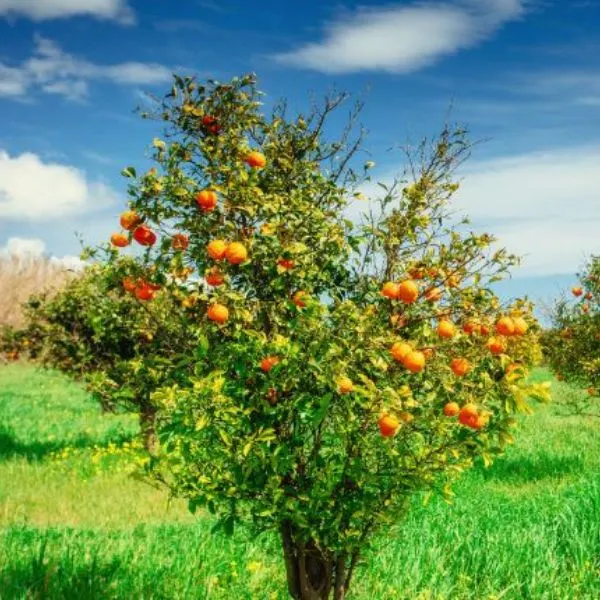
A fruit tree is a tree that bears edible fruit which is consumed by animals and humans.
All trees that flower (angiosperms) produce fruit, although the term “fruit tree” in horticulture refers only to those that provide fruit for human food.
Plant other fruit trees about 5 to 15 feet away from your apple tree.
It is not advisable to plant trees close to each another because they usually all start off with shallow roots that then grow deeper.
There would be competition between or among the trees for water and nutrients in the soil.
5. Mint
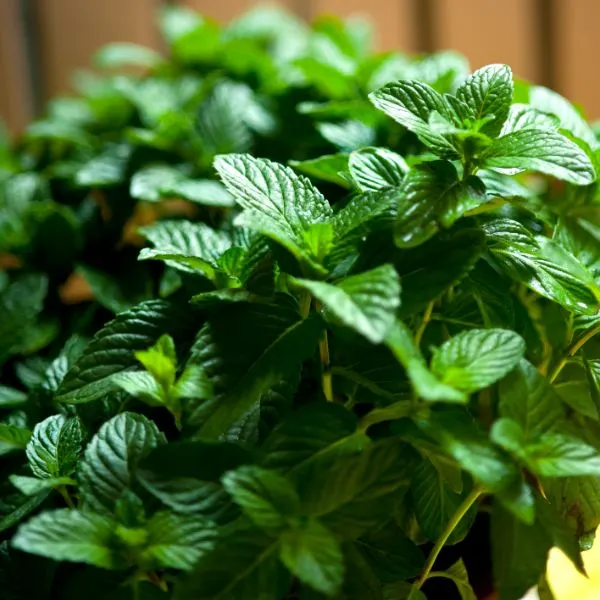
Mint is a genus of about sixty aromatic herbaceous flowering plants in the biological family Lamiaceae, the mint family.
Most plants in this genus are perennial, with several species, cultivars, and hybrids, such as peppermint.
These plants are known to be notorious spreaders, as they possess a fast-growing, horizontal root system.
More especially in its younger days (from 5 years and below), do not plant mint around your tree to ensure its invasive roots do not overpower and/ or kill the young tree.
6. Potatoes
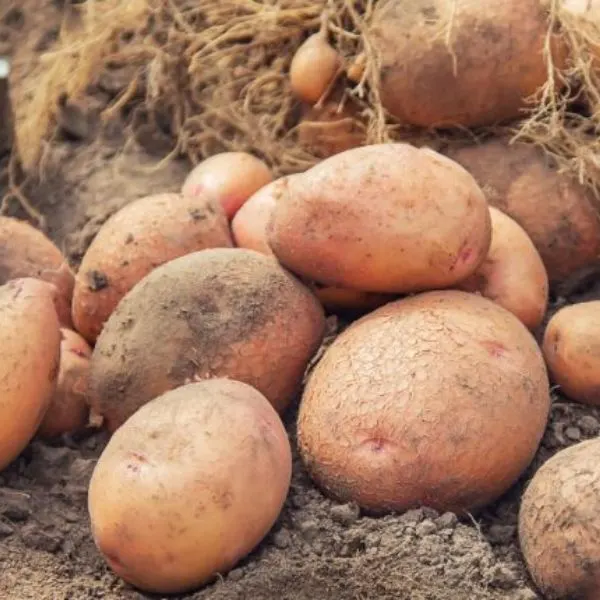
Potatoes are members of the nightshade family Solanaceae, like eggplants and peppers.
They are perennial plants grown as root vegetables. These starchy tubers are also not suitable for growing near apple trees.
As root vegetables, their roots grow downwards and reach low depths.
They also need relatively high levels of water for maximum growth.
Do not plant them near your apple tree to avoid unnecessary and harmful competition.
7. Tomatoes

A tomato plant is a South American plant of the nightshade family Solanaceae.
It produces a widely grown mildly acidic edible fruit also known as tomato, with many varieties in red or yellow color.
It is pulpy and may be eaten raw or cooked.
Like eggplants and potatoes, tomatoes have deep taproots that could compete with apple trees for nutrients and water.
Avoid growing them close to each other.
Plant your tomatoes elsewhere with plants that can protect them from pests.
Video about the top 8 Apple Tree Companions
Printable Guide

FAQs
What can I plant next to my apple tree?

Some very good companions to plant next to your apple tree are alliums (chives, garlic, onions), artemisia, chamomile, cicely, clover, comfrey, daffodils, dill, dogwood, fennel, geraniums, hyssop, lavender, legumes (such as alfalfa, beans, chickpeas, lentils, peanuts, peas, soybeans), parsley, rosemary, tansy and wildflowers (such as daisies, dandelions, marigolds, nasturtiums, poppies, yarrow).
What should you not plant next to an apple tree?

Do not plant carrots, conifers, eggplants, other fruit trees, mint, peppers, potatoes, tomatoes, or any other crop with deep and competitive roots next to your apple tree.
What grows best under apple trees?
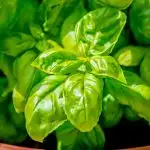
Crops that grow best under apple trees include artemisia, basil, chamomile, chives, dill, garlic, legumes, nasturtiums, and onions,
Can you plant cherry trees next to apple trees?

No, do not plant cherry trees or other fruit trees next to an apple tree. This could lead to competition between them.
Conclusion
Explained above are thirty-one (31) good companions you can grow with your apple tree and seven (7) bad companions you should not grow beside it.
Considered are root depth, amount of sunlight required, and benefits or disadvantages.
Similar to many other trees, apple trees have fundamental growing needs, including healthy, rich, or fertile soil, and a growing environment free of pests and insects or animals to help with plant reproduction by pollination.
Although a number of good companion plants help your tree more than others, plants that contribute to the health of the soil (like legumes), deter pests (like many herbs) or attract pollinators (beautiful flowers) bring benefits to apple trees.
Growing trees is beneficial to the environment
They produce oxygen which is essential for our survival and that of other animals.
They also help sustain populations of several animal species by providing food for us in form of fruits and leaves.
Trees can also absorb extra moisture from heavy rainfalls or storms. Drainage problems can be solved by simply planting more trees.
They prevent soil erosion and the movement of pollutants into water bodies.
In their earlier days, your apple tree will have shallow roots and may have to battle with its neighbors for nutrients, especially if such neighbors are grasses.
Its roots get deeper and find it easier to absorb nutrients when the tree is older.
For this reason, wait until your tree is five years old or older to grow companion plants like lemongrass and other types of grass around it.
At this age, the tree is more mature and can better handle having grasses around.
Check out more types of things:
